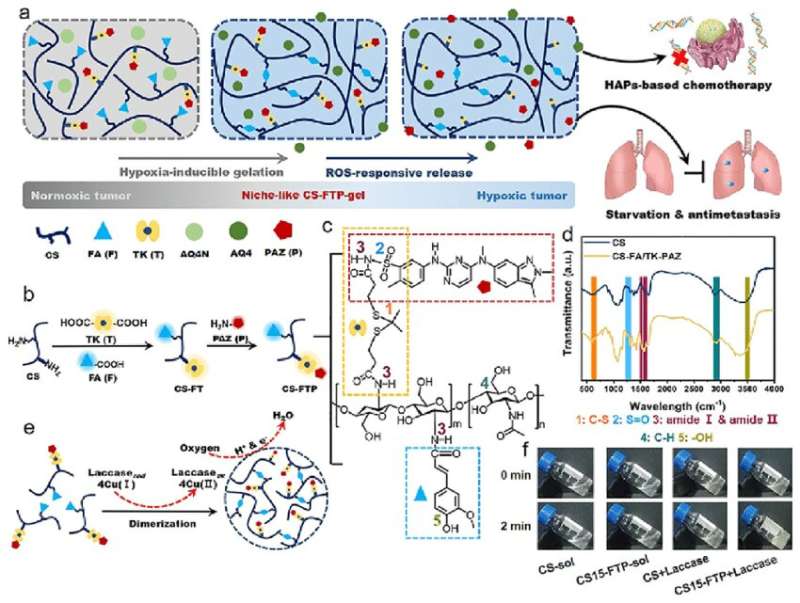This article has been reviewed according to Science X's editorial process and policies. Editors have highlighted the following attributes while ensuring the content's credibility:
fact-checked
proofread
Smart hydrogel with oxygen-scavenging capability inhibits tumor growth and metastasis

The development of various hypoxia-activated prodrugs (HAPs) has made considerable advances in the last few decades; however, cancer therapy using HAPs is still hindered by problems such as poor therapeutic outcomes due to difficulty in reaching the hypoxic region and metastasis resulting from hypoxia.
To that end, a team of researchers in China proposed a novel treatment approach capable of enhancing HAP-based chemotherapy and suppressing tumor metastasis.
Hangrong Chen, a professor at the Shanghai Institute of Ceramics, Chinese Academy of Sciences and one of the lead authors of the study, explained that solid tumors often contain areas with low oxygen concentration (hypoxia) near areas of necrosis. These hypoxic regions are resistant to both radiotherapy and chemotherapy, providing an opportunity for selective therapy such as prodrugs activated by hypoxia.
"HAPs, also known as bioreductive prodrugs, which can become toxic drugs in a hypoxia-dependent manner, are non-toxic in normoxic regions," added Chen. "However, one major hindrance for the clinical translations of HAPs is the inability to reach hypoxic regions that are distant from blood vessel network, which results in inadequate exposure to antitumor HAPs and contributes to low efficient chemotherapy."
The team created a novel hypoxia-inducible chitosan polymer that can be combined with antiangiogenic Pazopanib to form an injectable hydrogel that is sensitive to oxygen. Enzyme-mediated chemical reactions enable the polymers to react to oxygen and cause gelation.
By administering this oxygen scavenging hydrogel with HAPs, it is possible to improve the hypoxic environment of tumors, leading to heightened toxicity of HAP for selective chemotherapy. Furthermore, when exposed to elevated ROS in tumor regions, the responsive linkages within the hydrogel are broken, allowing sustained release of Pazopanib and inhibiting pulmonary metastasis.
The team's findings are published in Bioactive Materials.
In the study the oxygen elimination within the tumor was visualized in real-time with a micro-PET imaging technique provided by Professor Shaoli Song, a co-supervisor the study.
"This novel hydrogel can significantly remodel tumor hypoxic microenvironment as a kind of engineered niche," said Song. "We hope that our results will encourage scientists to continue investigating the use of HAP-based chemotherapy to combat cancer."
More information: Shi-Xiong Chen et al, In situ forming oxygen/ROS-responsive niche-like hydrogel enabling gelation-triggered chemotherapy and inhibition of metastasis, Bioactive Materials (2022). DOI: 10.1016/j.bioactmat.2022.08.002

















